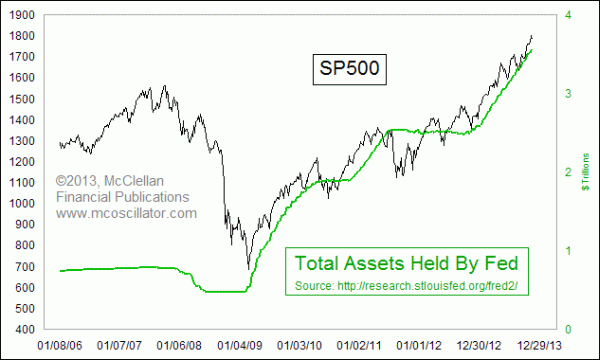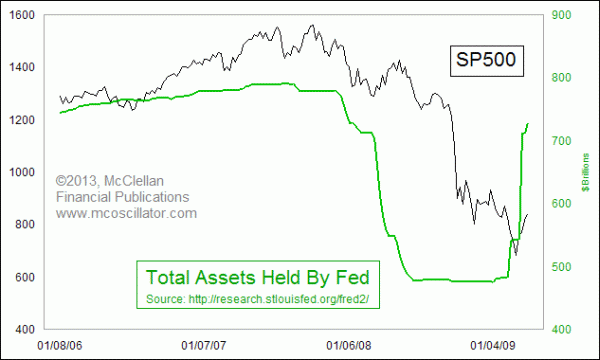At the start of every year I like to take the time and sketch out a game plan for the year. Part of that includes identifying major areas of risk and creating a mental game plan on how to respond. Two weeks ago, I identified interest rates as being one of my major concerns. When I speak of interest rates I am really speaking of the FED as their open market operations add or subtract to the economic liquidity which helps set interest rates. Its this liquidity (either too much or little) not only has the effect they desire by controlling interest rates but an unintended consequence is its indirect effect on the prices of other assets, such as stocks. So when I hear the FED is reducing liquidity I become concerned as this move in the past has been the catalyst for a market correction. An article from one the Fathers of technical analysis, Tom Mclellan, came across my inbox recently where he does a wonderful job at capturing this relationship and I thought it worthy of presenting its highlights. There are a lot of different indicators and studies that technical analysts use, and all of those tools came into usage due to some degree of merit. But the one factor which seems to be trumping everything else lately is what the Fed is doing with its QE program.
The chart below compares the SP500 to the total assets held by the Fed. The plot is made up from the total of the Fed's Treasury holdings and its mortgage backed securities (MBS), which are sometimes referred to as "agency" debt products. The agencies which that title refers to are Fannie Mae, Freddie Mac,
Putting the chart together this way helps us see just how important the Fed's purchases have been to the task of sustaining the bull market for stocks. Whenever the Fed has decided to change the slope of the green line, the slope of the SP500 has also changed in a dramatic way. That makes it such an important question to contemplate a "tapering" off in the rate of growth of Fed assets, or even an outright end to quantitative easing (QE).
The next chart also helps us see just how critical the Fed's actions were in bringing about the awful bear market of 2007-09. Back then, the Fed just held Treasuries, and it did not start buying agency debt until January 2009. The Fed's holdings of Treasury debt peaked in August 2007 at $790 billion, and over the next 17 months the Fed sold off more than $300 billion of those holdings. That's right, in the middle of the worst liquidity crisis in decades, with banks folding and with Congress handing out tax rebates, the Fed was pulling liquidity OUT of the banking system.
When the Fed finally stopped pulling liquidity out of the system and started adding it back in again in early 2009, the market turned upward, and the banking system and economy started working their way back toward health again.
Given the now obvious importance of the Fed's actions on financial market liquidity, why did they decide in 2007 and 2008 to pull so much money out of the system by selling so much of their Treasury holdings during that bear market? That will be a great question for the historians to uncover. But what I can say is that the man who orchestrated and conducted those sales, the former president of the New York Fed, left that job in early 2009 to become the new Treasury Secretary. So you can draw your own conclusions.
While the FED this month will begin slowing down the rate of stimulus (note I did not say stop completely or begin to withdrawal which has caused problems in the past) investors still must be concerned as one would expect at least some sort of impact to the economic bottom line. One reason to not be overly concerned is the FED understands it’s the rate of change that is most important and they have indicated any actions will be gradual in nature. Since we are in uncharted territory (QE first started in 2010), knowing how the market will react to future FED changes is anyone’s guess. As such, being prepared for anything and playing defense should be a top priority.

